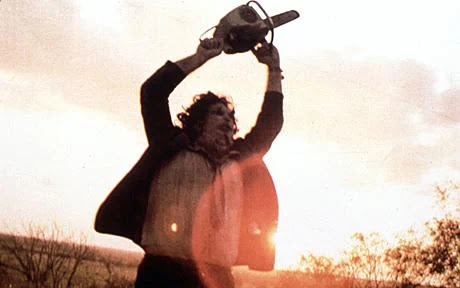The Texas Chainsaw Massacre
My rewatch of 1974's THE TEXAS CHAINSAW MASSACRE earlier this year was truly an awe inspiring experience. I did not remember how startlingly and laceratingly effective the movie is. Did I feel this way back in the '90s, when, after years of avoidance, gave in to see what all the fuss was about? It's been some time since I so fully experienced a film, one so pure and visceral. Co-writer/director Tobe Hooper has created something so vivid and alive it's almost mind boggling. Immersive? Hell yeah, even when watching at home. I can only imagine the power if viewed in a darkened theater. Maybe I'll get that opportunity someday.
The opening crawl (read very ominously by a pre fame John Larroquette) informs us the story we're about to see is true. The actual truth is the events are based on the exploits of a true life serial killer named Ed Gein who had earlier inspired PSYCHO. Hooper and Kim Henkel put Leatherface (Gunnar Hansen), a mute, chainsaw wielding sickie who wears a mask made of human flesh, in a decaying house filled with animal and human bones, derived from victims whose flesh was used for fresh cuts of barbeque to be sold at the local gas station, run by a weird guy we later learn is known as "The Cook" (Jim Siedow). A group of highly unfortunate youths, led by Sally (Marilyn Burns), will cross their paths. Not all will survive.
It's a standard plotline, one that would be rehashed countless times afterward. The young actors are attractive but far from characteristic. Burns, however, is called upon to be intensely physical and scream for at least half of the film's running time. TEXAS CHAINSAW's atmosphere is palpable from the opening credits, sustaining one of the most uncomfortable vibes I've experienced with a movie. Hooper really achieves something sinister and terrifying. Aiding is Robert A. Burns astonishingly disgusting art direction, Daniel Pearl's creative camerawork, and J. Larry Carroll and Sallye Richardson's maximum impact editing. There are also some effective moments of humor, particularly during the dinner table sequence late in the film, coming during perhaps the greatest fifteen minute stretch in any horror film, ever.
Inevitably, those looking for meaning will discern statements about the nihilistic zeitgeist of the '70s. A radio is sometimes audible in the background of certain scenes, its announcer matter of factly reporting on the latest atrocity. The iconic final seconds, as Leatherface maniacally swings his weapon of choice three hundred and sixty degrees during a sunrise, to me was an unmistakable statement on an ever omnipresent, maybe unstoppable Evil in the world.



Comments